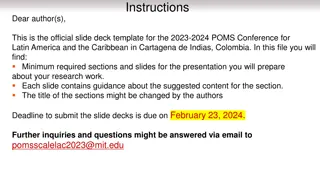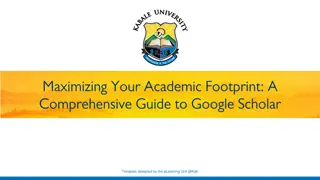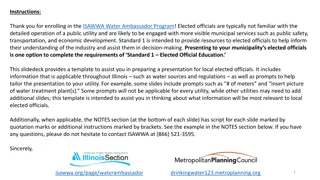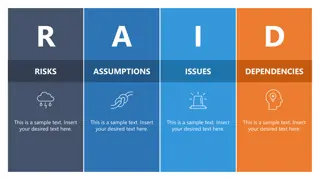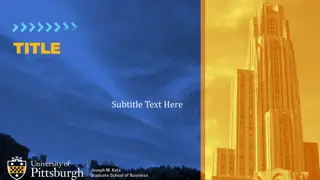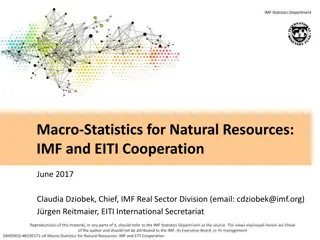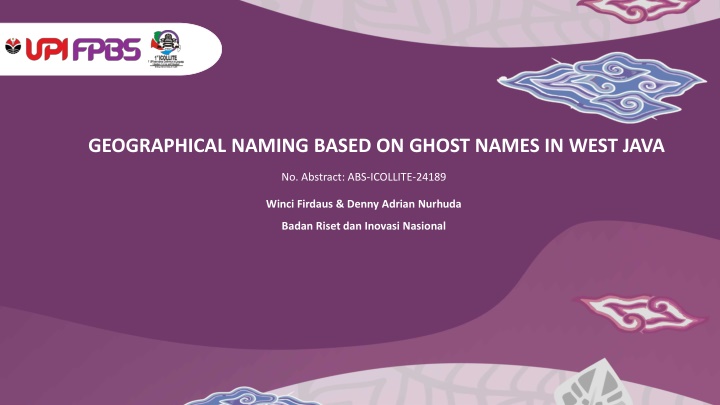
Geographical Naming Based on Ghost Names in West Java
Explore the unique practice of naming places in West Java after spirits, reflecting local beliefs and caution towards hazardous locations. This research delves into Sundanese people's supernatural beliefs and the significance of naming locations based on spirits.
Download Presentation

Please find below an Image/Link to download the presentation.
The content on the website is provided AS IS for your information and personal use only. It may not be sold, licensed, or shared on other websites without obtaining consent from the author. If you encounter any issues during the download, it is possible that the publisher has removed the file from their server.
You are allowed to download the files provided on this website for personal or commercial use, subject to the condition that they are used lawfully. All files are the property of their respective owners.
The content on the website is provided AS IS for your information and personal use only. It may not be sold, licensed, or shared on other websites without obtaining consent from the author.
E N D
Presentation Transcript
GEOGRAPHICAL NAMING BASED ON GHOST NAMES IN WEST JAVA No. Abstract: ABS-ICOLLITE-24189 Winci Firdaus & Denny Adrian Nurhuda Badan Riset dan Inovasi Nasional
INTRODUCTION In West Java, there are geographical names that use the names of jurig or spirits. The names of these spirits are used as geographic names as a prohibition on entering a place because it is hazardous, and also as a warning to be careful because that place can be dangerous for those who enter and may damage the natural preservation. The names of these spirits were given as geographical names because, in general, people are afraid of jurig. This assumption becomes a strong reason or the basis for why a place is named after one of the spirits so that people do not dare to enter the area. According to some people, ghosts are part of a legend because in a story they are considered to be real and experienced by someone. The function of this kind of legend is to confirm the truth of "superstitions" or people's beliefs. Geographical naming of a place can function as a unique marker of a place. It can be seen from the variety of natural phenomena combined with socio-cultural plurality in Indonesia, thus influencing diversity in naming a place based on local culture as an identity. Toponymy is a term related to physical, social and cultural aspects. According to Sundanese customs and conceptions, giving a name to someone should not be careless, considering that the process of giving or changing a name is sacred and has implications for the future. The difference between this research and previous research is that this is focusing on naming places, both village names, names related to mountains, or names related to water based on the names of spirits. Research related to this has not been carried out by other researchers, especially in West Java. Researchers will examine two things 1) Sundanese people's belief in supernatural beings in traditions and customs, and 2) the study of place names based on spirits.
METHOD This research uses analytical descriptive methods. It is a form of research aimed at describing existing phenomena, both natural and artificial phenomena. This research uses two data collection methods, namely the listening method and the proficient method. The listening method uses tapping techniques on informants. The tapping technique is also called the basic technique in the listening method (Mahsun, 2007, p. 92). This research uses tapping techniques followed by speaking-listening, note-taking and recording techniques. The researcher participated in the conversation and listened to the conversation in dialogue with the informant. Apart from that, researchers also took notes and recorded during the listening process. This research also uses skill methods in the form of fishing techniques because the researcher gives a prompt based on a list of questions to informants (Mahsun, 2007, p. 95).
FINDING AND DISCUSSION 1. SUNDANESE BELIEF IN SUPERNATURAL BEINGS IN TRADITIONS AND CUSTOMS Sundanese people initially saw nature as a unity of three worlds. In the Sundanese text at kropak 422, a text that contains Old Sundanese cosmology (a combination of Sundanese- Hindu and Buddhist), it is stated that the universe is divided into three worlds, namely sakala 'the real world', which is inhabited by creatures who have physical and spiritual, including humans, plants and other objects that can be seen, moving and still. Then niskala, 'the unseen world', which is believed to be inhabited by various incorporeal creatures and subtle elements in the form of gods and goddesses, nymphs, apsara-apsari, neutral spirits known as syanu, bayu, sadap, and hedap. Also, jantiniskala, the world of true magic, is inhabited by a single entity called Sanghyang Manon. The Almighty Creator is called Si Ijunajati Nistemen, the creator of limits but not subject to limits (Danasamita and Ekadjati, 2006, p. 25). In this description, Sundanese people initially believed that they did not live with their kind, there were other creatures (spiritual beings) which were usually referred to as lelembut and lelembutan. Lelembut is a non-human spirit, it has existed before, while lelembutan comes from the spirit of a deceased human. There are good and evil, the good is protective and the evil are disruptive. In the location category, some live on land (forests, mountains, caves, cemeteries), sky, water (rivers, lakes, rice fields, ponds, swamps and wells), trees (banyan, frangipani, cempaka, kenanga and etc). Some are ngageugeuh (inhabit and control) a place and are very cultural, meaning they are trusted, so that various customs and traditions emerge that distance them (Dofi, 2007).
FINDING AND DISCUSSION Naming Places Related to Water Situ Cibungaok, also known as Situ Danghi, is a natural lake located between Puncakyara Village and Cibangkong Village, Mekarjaya Village, Bungbulang District, Garut Regency. When the water is full, usually in the rainy season, the area of this lake can reach approximately 2-3 hectares. However, in the dry season, it will turn into a vast field. This geographical name is taken from a spirit creature called bungaok, a hideous demon (Satjadibrata, 2019). In the past, by naming bungaok, local residents would not dare to come to that place, let alone take the fish. The naming of the Cibungaok Lake is closely related to the aim of scaring the public so that they do not carelessly fish and the ecosystem remains well maintained. Onom Swamp, Onom is the term for astral creatures or demons. The legend of Onom originates from the time of the Galuh kingdom, which is said to have entrusted a patih (governor) to build a new territory in an area which now known as Pulo Majeti. The patih, Prabu Selang Kuning and his wife, Ratu Gandawati Sanghiang Ingkang Garwa, succeeded in turning the forest and swamp into a village complete with a magnificent palace. Here, the King then wanted to become a ruler and was reluctant to hand it over to the Galuh kingdom. In order to avoid conflict with the Galuh Kingdom, Prabu Selang Kuning invited his people to sleep so that they were referred to as a group of demons, which later became known as Onom. It is said that, in his achievement in leading Tatar Galuh, Onom's presence was invisibly used by Kanjeng Prebu so that at that time, this Regent was known to have relatively strong spiritual powers. Until now, the Rawa Onom village has become one of the mystical icons in Banjar City, with Pulo Majeti as a cultural heritage site whose preservation is now maintained.
FINDING AND DISCUSSION Naming Places Related to the Name of the Village Pamalayan Village, is 1 km east of Cijeungjing District, Ciamis Regency. It is said that this village is inhabited by a group of spirits that resemble children looking for yuyu (a type of crab) and frogs at night. Strangely enough, fire came out of the head of this creature, which burned like a torch. This creature showed up like an infection that night and stayed in the south (around Tanah Bengkok). From day to day, this story spread throughout the villages. Many people are curious about this story, so quite a few people want to prove it. The news then was heard by officials because of the excitement of the story. It is no longer surprising that the officials at that time wanted to prove it by being accompanied by para punggawa (soldiers). After that incident, Pamalayan Village became even more famous, not for its siti rejo, but for the janggitan (Pamalayan) which is synonymous with spirits (ghosts). Siluman Village, Siluman is known as a demon in English. Siluman Village is in Pabuaran District, Subang Regency. This village is the result of the expansion of Kadawung Village since 1908. The name of the village is taken from the name of the Cisiluman River, which is in Kadawung Village. Apart from that, the name of the village cannot be separated from the history of colonialism in Indonesia. It is said that the fighters hiding in the Cisiluman River could not be found by the invaders, who felt lost, as if obscured by a demon.
FINDING AND DISCUSSION Naming Places Related to Mountains Mount Kelong in Mekarwangi Village, Cihurip District, Garut Regency, and Curug Kelong in Cipicung Village, Culamega District, Tasikmalaya Regency. According to Satjadibrata (2019), "Kelong, ngaran jurig nation, pretending to ngarawu slaves". It can be said that kelong is the name of a devil who likes to take children away and is described as a demon that looks like a grandmother with very long breasts. In the 1960s in Pameungpeuk, Garut Regency, children who were busy playing when it was close to sunset and did not come home immediately after being called by their parents, the parents would say, "Hurry up and go home, you will be picked up by kelong." Hearing the word kelong, children were terrified, because news often spreads about children being kidnapped into the forest.
CONCLUSION Based on the results of the data analysis, the researchers can conclude that Sundanese people believe that they do not live with their kind. There are other creatures (spiritual beings) which are usually referred to as lelembut and lelembutan. In Old Sundanese cosmology, the universe is divided into three worlds, namely Sakala, 'the real world', which is inhabited by creatures who have physical and spiritual qualities, including humans, plants and other objects that can be seen, move and remain still. Then Niskala, 'the unseen world', which is believed to be inhabited by various incorporeal creatures and subtle elements in the form of gods and goddesses, nymphs, apsaras, neutral spirits known as syanu, bayu, sadap, and hedap. Also, Jantiniskala, the world of true magic , is inhabited by a single entity called Sanghyang Manon. Geographical naming patterns based on spirits in West Java can be classified into three parts, namely: 1) Naming places related to water, such as Situ Cibungaok, Kunti Island, Rawa Onom, and Leuei Jurig. 2) Naming places related to village names, such as Siluman Village, Satan Village, Pamalayan Village, and Munjul Kunti. 3) Naming places related to mountains, such as Jurig Crater, Siluman Crater, Upas Crater, and Mount Kelong.
REFERENCES Anshari, B. I., Dede, M., Tirtayasa, R., & Musthafa, K. (2017). Kajian Etnosemantik Dalam Toponimi Wilayah Kabupaten dan Kota Cirebon. Prosiding Seminar Internasional Leksikologi dan Leksikografi. Jakarta: FIB Universitas Indonesia. https://doi.org/10.31227/osf.io/5g6tw Camalia, M. (2015). Toponimi Kabupaten Lamongan (Kajian Antropologi Linguistik). Parole: Journal of Linguistics and Education, 5(1), 74-83. https://doi.org/10.14710/parole.v5i1.8625 Carroll, No l. (2003). The Philosophy of Horror: Or, Paradoxes of the Heart. Routledge. https://doi.org/10.4324/9780203361894 Cremers, Agus. 1997. Antara Alam dan Mitos. Flores: Nusa Indah Bravianingrum, Diessy Hermawati. (2011). Perbandingan Mitos Yang Terdapat Pada Legenda Ko-Sodate Yuurei (Jepang) dan Legenda Kuntilanak (Indonesia): Kajian Sastra Bandingan. Diglossia: Jurnal Kajian Ilmiah Kebahasaan dan Kesusastraan, 3(1). https://doi.org/10.26594/diglossia.v3i1.80 Danasasmita, S., Darsa, U. A., & Ekadjati, E. S. (2006). Mencari Gerbang Pakuan dan kajian lainnya mengenai budaya Sunda. Bandung: Yayasan Pusat Studi Sunda. Danandjaja, James. (2007). Folklor Indonesia. Jakarta: Pustaka Utama Grafiti. Dofi, Bellavia A. (2007). Psikologi Makhluk Halus. Jakarta: Inti Media Publisher Humaeni, A. (2013). Makna Kultural Mitos dalam Budaya Masyarakat Banten. Jurnal Antropologi Indonesia. https://doi.org/10.7454/ai.v33i3.2461 Kasmana, K., dkk. (2018). Perwujudan Keyakinan akan Keberadaan Mahluk Halus dalam Komik Kawin ka Kunti. Jurnal Panggung, 26(3). https://doi.org/10.26742/panggung.v26i3.192 Kosasih, D., Hendrayana, D., Firdaus, W., & Nurhuda, D. A. (2023). Sistem Nama Diri Masyarakat Adat Kasepuhan Ciptagelar. Ranah: Jurnal Kajian Bahasa, 12(1), 101-112. https://doi.org/10.26499/rnh.v12i1.6106 Mahsun. (2007). Metode Penelitian Bahasa. Jakarta: PT Raja Grafindo Persada. Mido, Frans. (1994). Cerita Rekaan dan Seluk Beluknya. Flores NTT Indonesia: Nusa Indah Rais, Jacub, et al. (2008). Toponimi: Sejarah Budaya yang Panjang dari Pemukiman Manusia dan Tertib Administrasi. Jakarta: Pradnya Paramita. Risnawati, R. (2018, February). Bentuk Mitos Jawa dalam Novel Simple Miracle: Doa dan Arwah Karya Ayu Utami sebagai Piranti Pendidikan Karakter (Kajian Antropologi Sastra). dalam Prosiding Seminar Nasional Bahasa dan Sastra Indonesia (SENASBASA). 1(1). Saputra, A. D., & Limbong, E. G. (2019). Visualisasi Karakter Pocong, Kuntilanak, dan Tuyul pada Film Animasi Keluarga Hantu Indonesia. Jurnal Desain, 7(1), 1-11. https://doi.org/10.30998/jd.v7i01.5468 Satjadibrata, R. (2019). Kamus Sunda-Indonesia (Cetakan III). Bandung: Kiblat Buku Utama Suhendi, I. D. (2015). Pandangan Dunia Orang Sunda dalam Cerita Kuntilanak sebagai Legenda Alam Gaib di Kota Bandung. Doctoral dissertation. Universitas Pendidikan Indonesia. Sukmadinata. (2006). Metode Penelitian Kualitatif. Bandung: Remaja Rosdakarya. Sumarsono. (2007). Sosiolinguistik. Yogyakarta: Pustaka Pelajar Sabda. Taqyuddin. (2016). Punahnya Toponimi: Indikasi Erosi Bahasa dan Punahnya Bangsa. Geospasial. 14(3). 29 34.







